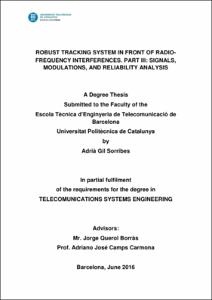Robust Tracking System in front of Radio-Frequency Interferences. Part 3: Signals, Modulations, and Reliability analysis

Visualitza/Obre
Estadístiques de LA Referencia / Recolecta
Inclou dades d'ús des de 2022
Cita com:
hdl:2117/90114
Tipus de documentTreball Final de Grau
Data2016-06
Condicions d'accésAccés obert
Tots els drets reservats. Aquesta obra està protegida pels drets de propietat intel·lectual i
industrial corresponents. Sense perjudici de les exempcions legals existents, queda prohibida la seva
reproducció, distribució, comunicació pública o transformació sense l'autorització del titular dels drets
Abstract
The aim of this project is to simulate and implement a Robust Tracking System (RTS), capable of tracking a transmitter when Global Position System (GPS) signals are not available, offering high resistance to Radio Frequency Inference signals (RFI). This is a project developed in the Theory of the Signal and Communication (TSC) Department in the Universitat Politècnica de Catalunya (UPC). RTS combines the use of the hyperbolic navigation techniques; the Least Mean Squares (LMS) algorithm, to estimate the transmitter position; and the use of a spread-spectrum signal modulation, in order to achieve greater robustness against RFI signals. A study and comparison of the different spread-spectrum modulations is performed in order to find out the best one and an implementation with the available hardware is designed to examine the performance of this modulation in a real scenario. The spread-spectrum modulation that has proven to be the best for the system is the Frequency Hopping Spread-Spectrum (FHSS) since it is the one that provides a greater Signal-to-Interference Ratio (SIR) after the demodulation has been performed. Future work will be oriented to the design of an application that would gather all the information and present it to the final user in a more visual way. III Resumen El objetivo de este proyecto es simular e implementar un sistema capaz de rastrear un transmisor cuando el sistema de posicionamiento global (GPS) no está disponible, un sistema que ofrezca una alta resistencia a las señales interferentes de radio, llamado Robust Tracking System (RTS). Se trata de un proyecto desarrollado en el Departamento de Teoría de la Señal y Comunicaciones (TSC) en la Universidad Politécnica de Cataluña (UPC). RTS combina el uso de las técnicas de navegación hiperbólica; el método de mínimos cuadrados, para estimar la posición del transmisor; y el uso de una modulación de señal de espectro ensanchado, con el fin de lograr una mayor robustez frente a señales radio interferentes. Se ha realizado un estudio, así como una comparación de las diferentes modulaciones de espectro ensanchado para determinar la mejor e implementarla usando el hardware disponible para examinar, de este modo, el comportamiento del sistema en un escenario real. La modulación de espectro ensanchado que ha demostrado ser la mejor para el sistema es la ?Frequency Hopping Spread-Spectrum? (FHSS), ya que es la que proporciona una mayor relación de señal a interferente una vez se ha hecho la demodulación de la señal recibida. Un trabajo para el futuro podría ser el diseño de una aplicación que reúna toda la información del sistema y la presente al usuario final de una manera visual e interactiva. L'objectiu d'aquest projecte és simular i implementar un sistema capaç de rastrejar un transmissor quan el sistema de posicionament global (GPS) no està disponible, un sistema que ofereixi una alta resistència als senyals ràdio interferents, anomenat Robust Tracking System (RTS). Es tracta d'un projecte desenvolupat al Departament de Teoria del Senyal i Comunicacions (TSC) a la Universitat Politècnica de Catalunya (UPC). RTS combina l'ús de les tècniques de navegació hiperbòlica; el mètode de mínims quadrats, per estimar la posició del transmissor; i l'ús d'una modulació de senyal d'espectre eixamplat, per tal d'aconseguir una major robustesa enfront de senyals ràdio interferents. S'ha realitzat un estudi, així com una comparació de les diferents modulacions d'espectre eixamplat per determinar la millor i implementar-la usant el hardware disponible per examinar, d'aquesta manera, el comportament del sistema en un escenari real. La modulació d'espectre eixamplat que ha demostrat ser la millor per al sistema és la "Frequency Hopping Spread-Spectrum" (FHSS), ja que és la que proporciona una major relació de senyal a interferent un cop s'ha fet la desmodulació del senyal rebut. Un treball per al futur podria ser el disseny d'una aplicació que reuneixi tota la informació del sistema i la presenti a l'usuari final d'una manera visual i interactiva.
Descripció
This project deals with the study of those signals and modulations suitable for a Robust Tracking System in front of Radio-Frequency Interferences.
MatèriesSignal processing -- Digital techniques, Radio frequency, Digital modulation, Tractament del senyal -- Tècniques digitals, Radiofreqüència, Modulació digital
TitulacióGRAU EN ENGINYERIA DE SISTEMES DE TELECOMUNICACIÓ (Pla 2010)
| Fitxers | Descripció | Mida | Format | Visualitza |
|---|---|---|---|---|
| Degree_thesis_Adria_Gil.pdf | 4,093Mb | Visualitza/Obre |

